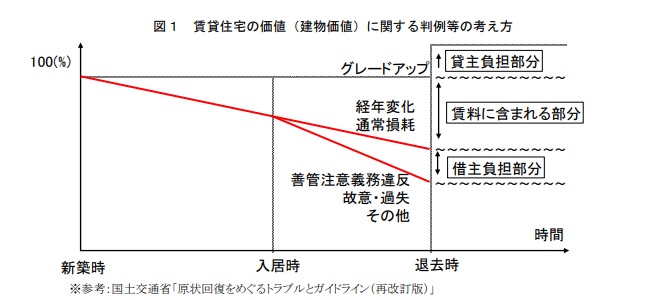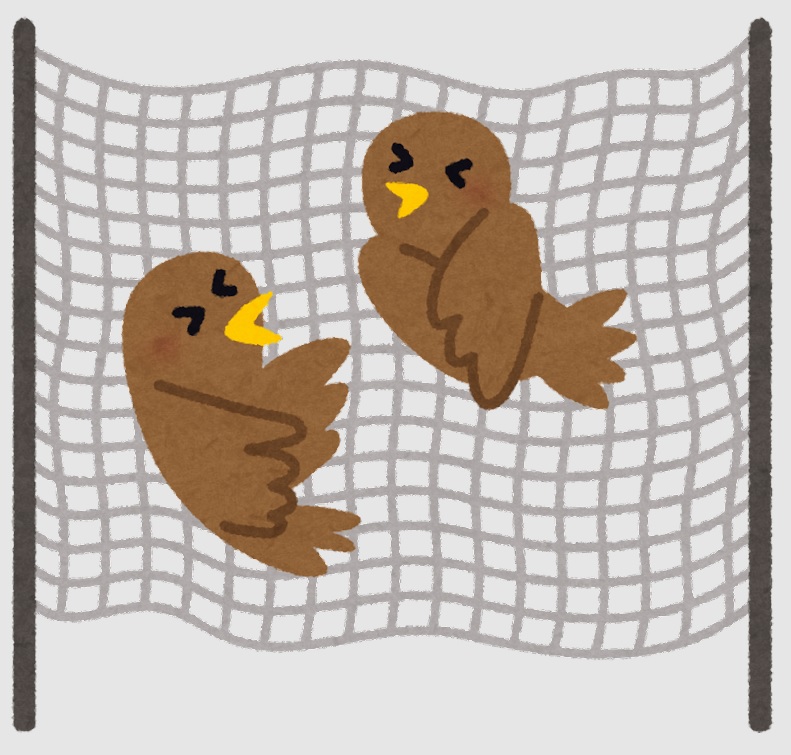「残存価格|知ってトクする現状回復」
今日は【貯める力】
退去費用を下げる方法の追加解説
をお話しします。
●退去費用をムダに払わない!~現状回復の真実を知って賢く守ろう~

賃貸物件を退去する時に
綺麗に使ってたとしても
本当に悪どい業者が多くて
結構ボッタクってくる事が多いです。
退去の時にボッタクられない様に
現状回復の意味を覚えて
注意しようというお話しを以前しました。
(関連記事)
過去にボッタクリにあった人が
非常に多いケースなので
以前のお話しに続いて
もう少し追加でお話しします。
●現状回復の誤解を防ぐ!~本当に直すべきはどこなのか~

前回の復習ですが
最低限覚えておいて欲しいのは
退去の時に問題になる事が多い
『現状回復費用』です。
結局どこを直すのか?という事です。
現状回復費用とは何か?
再度確認しておきたいのは
物件を借りた当初の状態に
直す事ではない。
物件を借りた時に新品だったとしても
退去時に新品に戻すという事が
現状回復ではありません。

通常損耗というのは
自然にすり減ったりしますよね?
普通に使ってて
普通に減っていく価値の部分というのは
畳がすり減ったり
クロスもこすれたりとか
これは自然な事ですよね?
ここは直す必要が無いんですよ。
そして現状回復費の負担というのは
故意とか過失で
壊してしまった部分についてなんですよ。
例えば壁を叩いて穴を開けたとか。
この部分だけを直すんですよね。
故意や過失で
壊してしまった部分だけを直す。
ただこの部分を直すんですけど
『残存価格』で直すんですよね。
残存価格とは
耐用年数で残っている価値の事です。
仮に
壁のビニールクロス(以下クロス)が
全部で10万円したとします。
クロスというのは
耐用年数が決まっています。
・クロス 6年
・畳 6年
など全部決まっています。
当初新品だったものが
年々価値が減っていくというのが
通常であるという考え方です。
6年住んだ場合
クロスの価値というのは
1円になるんですよ。
だから価値は無い。
だから仮に壊してしまったとしても
1円の物を傷つけたんだから
実質価値は無いですよね?
という事です。
〜〜〜つづく〜〜〜
Special Thanks college president Ryo.
●おまけ
≪≪Chat-GPTくんによる要約→perplexityちゃんによる文章まとめ≫≫
賃貸物件の退去時に注意すべきは、現状回復費用の正しい理解です。重要なポイントは、借りた当初の新品状態に戻す必要がないことです。通常の使用による劣化(畳のすり減りやクロスのこすれなど)は修繕不要で、故意や過失による損傷のみが対象となります。
物件の各部位には耐用年数があり、例えばクロスは6年で価値が1円になります。長期間住んでいる場合、損傷があっても実質的な修繕費用は極めて低くなります。これらの知識を持つことで、不当に高額な退去費用請求を防ぎ、適切な費用負担で退去できるでしょう。賢明な対応が、ボッタクリから身を守る鍵となります。
Citations:
[1] https://fukuoka-leapup.jp/column/leasing/movingout-fee/
[2] https://urashico2.com/blog/ideas-to-lower-moving-costs/
[3] https://urashico2.com/blog/satisfied-cost-leaving-rental-property/
[4] https://www.hikkoshi-line.com/navi/decision/rent-repaircosts.html
[5] https://www.kansai-gakusei-mansion.com/blog/entry-34/
[6] https://bf-consulting.jp/can-i-use-my-insurance-for-restoration/
[7] https://www.102704.com/column/column80/
[8] https://vs-group.jp/lawyer/tachinoki/costs/taikyosouba/
≪≪Chat-GPTくんによる英訳≫≫
Today, I’ll be providing an additional explanation on how to reduce move-out costs.
【Don’t Overpay When Moving Out! – Know the Truth About Restoration Costs and Protect Yourself Wisely】
Even if you have kept the rental property in good condition, unfortunately, there are many dishonest contractors who tend to overcharge.
To avoid being overcharged during the move-out process, I previously discussed the importance of understanding the meaning of restoration costs and being cautious.
(See related article)
Episode 14-2: How to Lower Move-Out Costs
There are many cases where people have been overcharged in the past, so I’ll continue with a bit more explanation from the previous discussion.
Prevent Misunderstandings About Restoration Costs! – Know What Really Needs to Be Fixed
As a recap from the previous discussion, the most important thing to remember is the concept of restoration costs, which often becomes an issue during move-out.
The main question is: What exactly needs to be repaired?
What are restoration costs?
It’s important to clarify that restoration costs do not mean returning the property to its original condition when it was first rented.
Even if the property was new when you moved in, restoring it to its brand-new state when you move out is not the goal of restoration costs.
Normal wear and tear happens naturally, right?
Parts of the property naturally lose value over time as you use them.
For example, tatami mats may get worn down, or the wallpaper (vinyl wall covering) may show signs of rubbing. These are natural occurrences.
These don’t need to be repaired.
Restoration costs are only meant to cover the damage caused by intentional actions or negligence.
For instance, if you accidentally put a hole in the wall, that would need to be repaired.
Only the damaged parts, caused by your actions or mistakes, are what need to be fixed.
However, these repairs are done based on the “residual value,” which refers to the remaining value of the item according to its useful life.
For example, if the total cost of the vinyl wallpaper was 100,000 yen, this wallpaper has a determined useful life.
– Wallpaper: 6 years
– Tatami mats: 6 years
These are all set and determined. Over time, the value of items that were new when you moved in naturally decreases.
If you lived in the property for 6 years, the value of the wallpaper would drop to 1 yen.
So, the value would be negligible.
Even if you damaged something, the value of the object is so low (1 yen) that the damage would essentially be meaningless in terms of cost.
That’s the point.
Special Thanks OpenAI and Perplexity AI, Inc


